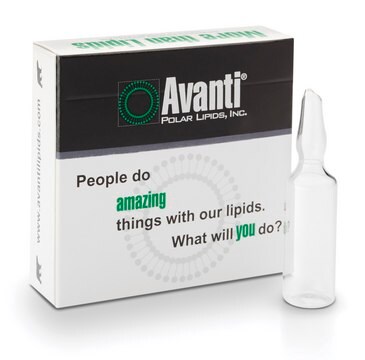870602P
Avanti
PGPC
Avanti Research™ - A Croda Brand 870602P, powder
Synonym(s):
1-palmitoyl-2-glutaryl-sn-glycero-3-phosphocholine
Sign Into View Organizational & Contract Pricing
All Photos(1)
About This Item
Empirical Formula (Hill Notation):
C29H56NO10P
CAS Number:
Molecular Weight:
609.73
UNSPSC Code:
12352211
NACRES:
NA.25
Recommended Products
form
powder
packaging
pkg of 1 × 1 mg (870602P-1mg)
pkg of 1 × 5 mg (870602P-5mg)
manufacturer/tradename
Avanti Research™ - A Croda Brand 870602P
shipped in
dry ice
storage temp.
−20°C
SMILES string
[O-]P(OCC[N+](C)(C)C)(OC[C@]([H])(OC(CCCC(O)=O)=O)COC(CCCCCCCCCCCCCCC)=O)=O
General description
1-palmitoyl-2-glutaryl-sn-glycero-3-phosphocholine (PGPC) is a constituent of oxidatively modified low density lipoproteins (oxLDLs). It is synthesized from the non-enzymatic oxidation of a major low-density lipoproteins (LDL) phospholipid, 1-palmitoyl-2-arachidonoyl-sn-glycero-3-phosphocholine (PAPC).
Application
1-palmitoyl-2-glutaryl-sn-glycero-3-phosphocholine (PGPC) has been used to study its effect on plasma membrane nanoplatforms using single-molecule microscopy.
Biochem/physiol Actions
1-palmitoyl-2-glutaryl-sn-glycero-3-phosphocholine (PGPC) acts as an inducer of inflammation, proliferation or apoptosis in cultured vascular smooth muscle cells and macrophages. It is accumulated in atherosclerotic lesions.
Packaging
5 mL Clear Glass Sealed Ampule (870602P-1mg)
5 mL Clear Glass Sealed Ampule (870602P-5mg)
Legal Information
Avanti Research is a trademark of Avanti Polar Lipids, LLC
Storage Class Code
11 - Combustible Solids
Choose from one of the most recent versions:
Certificates of Analysis (COA)
Lot/Batch Number
Sorry, we don't have COAs for this product available online at this time.
If you need assistance, please contact Customer Support.
Already Own This Product?
Find documentation for the products that you have recently purchased in the Document Library.
The role of high-density lipoproteins in oxidation and inflammation
Van Lenten B, et al.
Trends in Cardiovascular Medicine, 11(3-4), 155-161 (2001)
The oxidized phospholipids POVPC and PGPC inhibit growth and induce apoptosis in vascular smooth muscle cells
Fruhwirth GO, et al.
Biochimica et Biophysica Acta - Molecular and Cell Biology of Lipids, 1761(9), 1060-1069 (2006)
Oxidized phospholipids inhibit the formation of cholesterol-dependent plasma membrane nanoplatforms
Brameshuber M, et al.
Biophysical Journal, 110(1), 205-213 (2016)
Alexandra Moumtzi et al.
Journal of lipid research, 48(3), 565-582 (2006-12-01)
Lipid oxidation is now thought to be an initiating and sustaining event in atherogenesis. Oxidatively fragmented phospholipids, namely 1-palmitoyl-2-glutaroyl-sn-glycero-3-phosphocholine (PGPC) and 1-palmitoyl-2-(5-oxovaleroyl)-sn-glycero-3-phosphocholine (POVPC), present in minimally modified LDL and atherosclerotic lesions, have been reported to elicit a wide range of
Oxidized Phospholipids Inhibit the Formation of Cholesterol-Dependent Plasma Membrane Nanoplatforms.
Mario Brameshuber et al.
Biophysical journal, 110(1), 205-213 (2016-01-09)
We previously developed a single-molecule microscopy method termed TOCCSL (thinning out clusters while conserving stoichiometry of labeling), which allows for direct imaging of stable nanoscopic platforms with raft-like properties diffusing in the plasma membrane. As a consensus raft marker, we
Our team of scientists has experience in all areas of research including Life Science, Material Science, Chemical Synthesis, Chromatography, Analytical and many others.
Contact Technical Service







